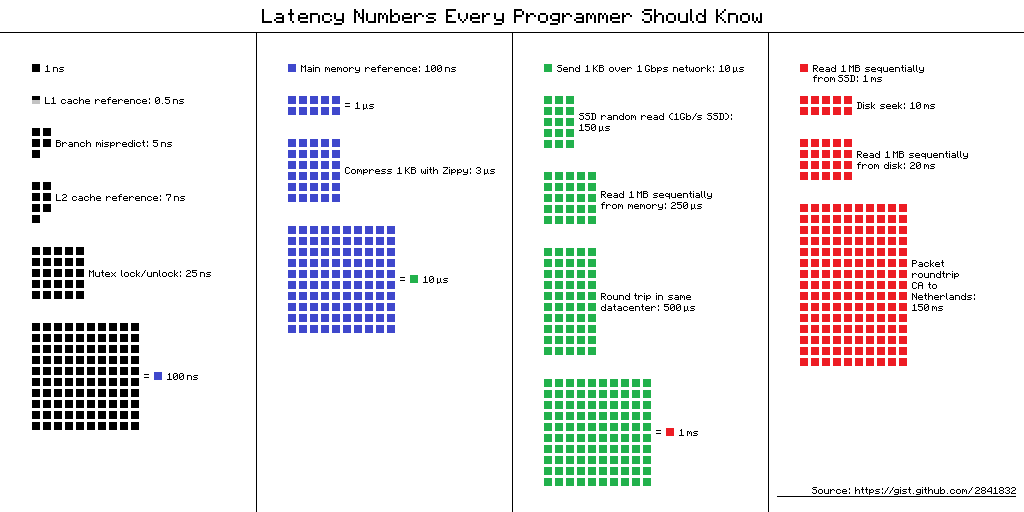Primer
Back of the Envelope Calculation
Introduction to Layer 7 Protocol RPC
Powers of two table
| Power | Exact Value | Approx Value | Bytes |
|---|---|---|---|
| 7 | 128 | ||
| 8 | 256 | ||
| 10 | 1024 | 1 thousand | 1 KB |
| 16 | 65,536 | 64 KB | |
| 20 | 1,048,576 | 1 million | 1 MB |
| 30 | 1,073,741,824 | 1 billion | 1 GB |
| 32 | 4,294,967,296 | 4 GB | |
| 40 | 1,099,511,627,776 | 1 trillion | 1 TB |
Latency numbers every programmer should know

| Operation | Latency (ns) | Latency (us) | Latency (ms) | Notes |
|---|---|---|---|---|
| L1 cache reference | 0.5 | — | — | |
| Branch mispredict | 5 | — | — | |
| L2 cache reference | 7 | — | — | 14x L1 cache |
| Mutex lock/unlock | 25 | — | — | |
| Main memory reference | 100 | — | — | 20x L2 cache, 200x L1 cache |
| Compress 1K bytes with Zippy | 10,000 | 10 | — | |
| Send 1 KB over 1 Gbps network | 10,000 | 10 | — | |
| Read 4 KB randomly from SSD* | 150,000 | 150 | — | ~1GB/sec SSD |
| Read 1 MB sequentially from memory | 250,000 | 250 | — | |
| Round trip within same datacenter | 500,000 | 500 | — | |
| Read 1 MB sequentially from SSD* | 1,000,000 | 1,000 | 1 | ~1GB/sec SSD, 4X memory |
| HDD seek | 10,000,000 | 10,000 | 10 | 20x datacenter roundtrip |
| Read 1 MB sequentially from 1 Gbps net | 10,000,000 | 10,000 | 10 | 40x memory, 10X SSD |
| Read 1 MB sequentially from HDD | 30,000,000 | 30,000 | 30 | 120x memory, 30X SSD |
| Send packet CA → Netherlands → CA | 150,000,000 | 150,000 | 150 |
Notes
- 1 ns = 10⁻⁹ seconds
- 1 µs = 10⁻⁶ seconds = 1,000 ns
- 1 ms = 10⁻³ seconds = 1,000 µs = 1,000,000 ns
- Read sequentially from HDD at 30 MB/s
- Read sequentially from 1 Gbps Ethernet at 100 MB/s
- Read sequentially from SSD at 1 GB/s
- Read sequentially from the main memory at 4 GB/s
- 6–7 worldwide round trips per second
- 2,000 round trips per second within a data center
Availability numbers
High availability is the ability of a system to be continuously operational for a desirably long period of time. High availability is measured as a percentage, with 100% means a service that has 0 downtime. Most services fall between 99% and 100%. A service level agreement (SLA) is a commonly used term for service providers. This is an agreement between you (the service provider) and your customer, and this agreement formally defines the level of uptime your service will deliver. Cloud providers Amazon [4], Google [5] and Microsoft [6] set their SLAs at 99.9% or above. Uptime is traditionally measured in nines. The more the nines, the better. As shown in Table 3, the number of nines correlate to the expected system downtime.| Availability % | Downtime per day | Downtime per week | Downtime per month | Downtime per year |
|---|---|---|---|---|
| 99% | 14.40 minutes | 1.68 hours | 7.31 hours | 3.65 days |
| 99.99% | 8.64 seconds | 1.01 minutes | 4.38 minutes | 52.60 minutes |
| 99.999% | 864.00 milliseconds | 6.05 seconds | 26.30 seconds | 5.26 minutes |
| 99.9999% | 86.40 milliseconds | 604.80 | 2.63 seconds | 31.56 seconds |
Example: Estimate Twitter QPS and storage requirements
Please note the following numbers are for this exercise only as they are not real numbers from Twitter. Assumptions:- 300 million monthly active users.
- 50% of users use Twitter daily.
- Users post 2 tweets per day on average.
- 10% of tweets contain media.
- Data is stored for 5 years.
- Daily active users (DAU) = 300 million * 50% = 150 million
- Tweets QPS = 150 million * 2 tweets / 24 hour / 3600 seconds = ~3500
- Peek QPS = 2 * QPS = ~7000
- Average tweet size:
- tweet_id 64 bytes
- text 140 bytes
- media 1 MB
- Media storage: 150 million * 2 * 10% * 1 MB = 30 TB per day
- 5-year media storage: 30 TB * 365 * 5 = ~55 PB

